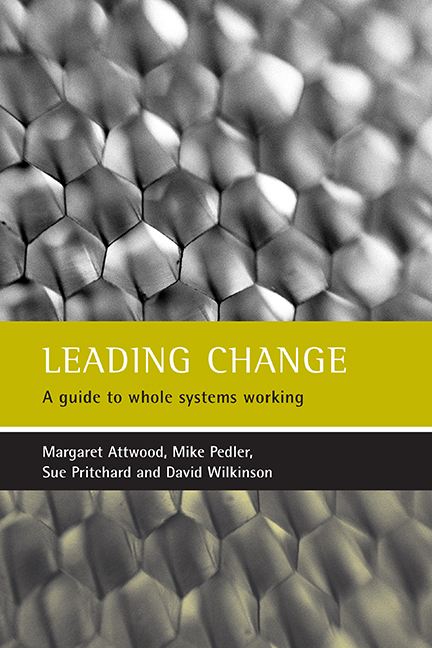Book contents
- Frontmatter
- Contents
- Foreword
- Foreword
- Prologue
- one Why do we need whole systems change?
- Two How Do We Put These Fine Words Intoaction? An Overview of Whole Systems Development
- Three The emerging practice of wholesystems development
- Four Leadership: keeping the big picture in view
- Five Public learning
- Six Valuing difference and diversity: getting the whole systeminto the room
- Seven Meeting differently: large and small group working
- Eight Follow-through and sticking with it
- Nine From organisations to networks
- Ten Confirming cases: local problems andlocal solutions within whole systems
- Epilogue
- Bibliography
- Index
Six - Valuing difference and diversity: getting the whole systeminto the room
Published online by Cambridge University Press: 20 January 2022
- Frontmatter
- Contents
- Foreword
- Foreword
- Prologue
- one Why do we need whole systems change?
- Two How Do We Put These Fine Words Intoaction? An Overview of Whole Systems Development
- Three The emerging practice of wholesystems development
- Four Leadership: keeping the big picture in view
- Five Public learning
- Six Valuing difference and diversity: getting the whole systeminto the room
- Seven Meeting differently: large and small group working
- Eight Follow-through and sticking with it
- Nine From organisations to networks
- Ten Confirming cases: local problems andlocal solutions within whole systems
- Epilogue
- Bibliography
- Index
Summary
We are seeing a societal learning curve where people are moving from a tendency to rely on experts to solve problems or to improve whole systems to individuals themselves wanting more control over issues that critically affect their lives. We see this in demands to be involved: by parents in decisions about the education of their children; by patients and carers in decisions about their personal health and social care; by communities in debates about the future of institutions such as hospitals or schools and in planning decisions. People are disenchanted with their inability to have a real voice in a society. This is also reflected in the apparent apathy of many people, often reflected by low turnouts at local and national elections.
Marvin Weisbord has characterised this as a historical trend over the lastcentury:
• 1900 – experts solve problems
• 1950 – ‘everybody’ solves problems
• 1965 – experts improve whole systems
• 2000 – ‘everybody’ improves whole systems (Weisbord and Janoff, 1995, p 2)
We are not suggesting that whole systems development is the universal panacea for all these ills. However, the principle that anyone affected by a change should be an architect of it does assist thinking about ways in which diverse perspectives and aspirations can be incorporated into decisions to improve the circumstances in which people live and work. People of all political persuasions and social and economic circumstances can have a hand in painting the big picture. They can start to align their own actions with those of colleagues or fellow citizens to bring this into being.
In this chapter we:
• explore how the difference and diversity within the whole system can beutilised to the benefit of all stakeholders;
• address how the whole system can come ‘into the room together’ to workon complex issues such as partnerships between organisations, ways ofimproving education or healthcare or dealing with urban poverty;
• discuss ways of ensuring that the voices of disadvantaged groups on the margin of society are heard, if not directly at least indirectly, in whole systems development.
Inviting local residents to plan the future of their communities
Your Community Tomorrow
A Better Future For All
We are forging a new direction, where local people have a say in their tomorrow. If you are an individual or part of a group interested in building the future together, we need to hear your views.
- Type
- Chapter
- Information
- Leading ChangeA Guide to Whole Systems Working, pp. 95 - 110Publisher: Bristol University PressPrint publication year: 2003



